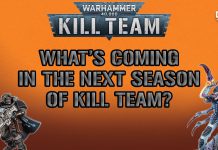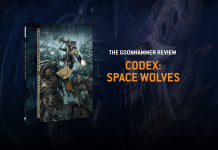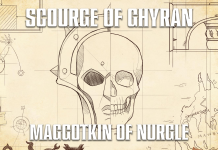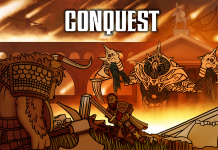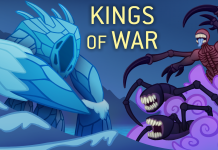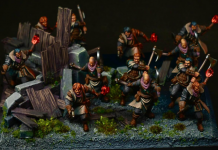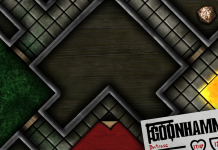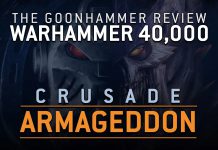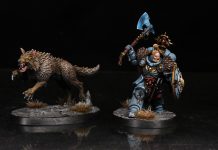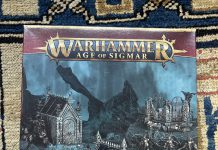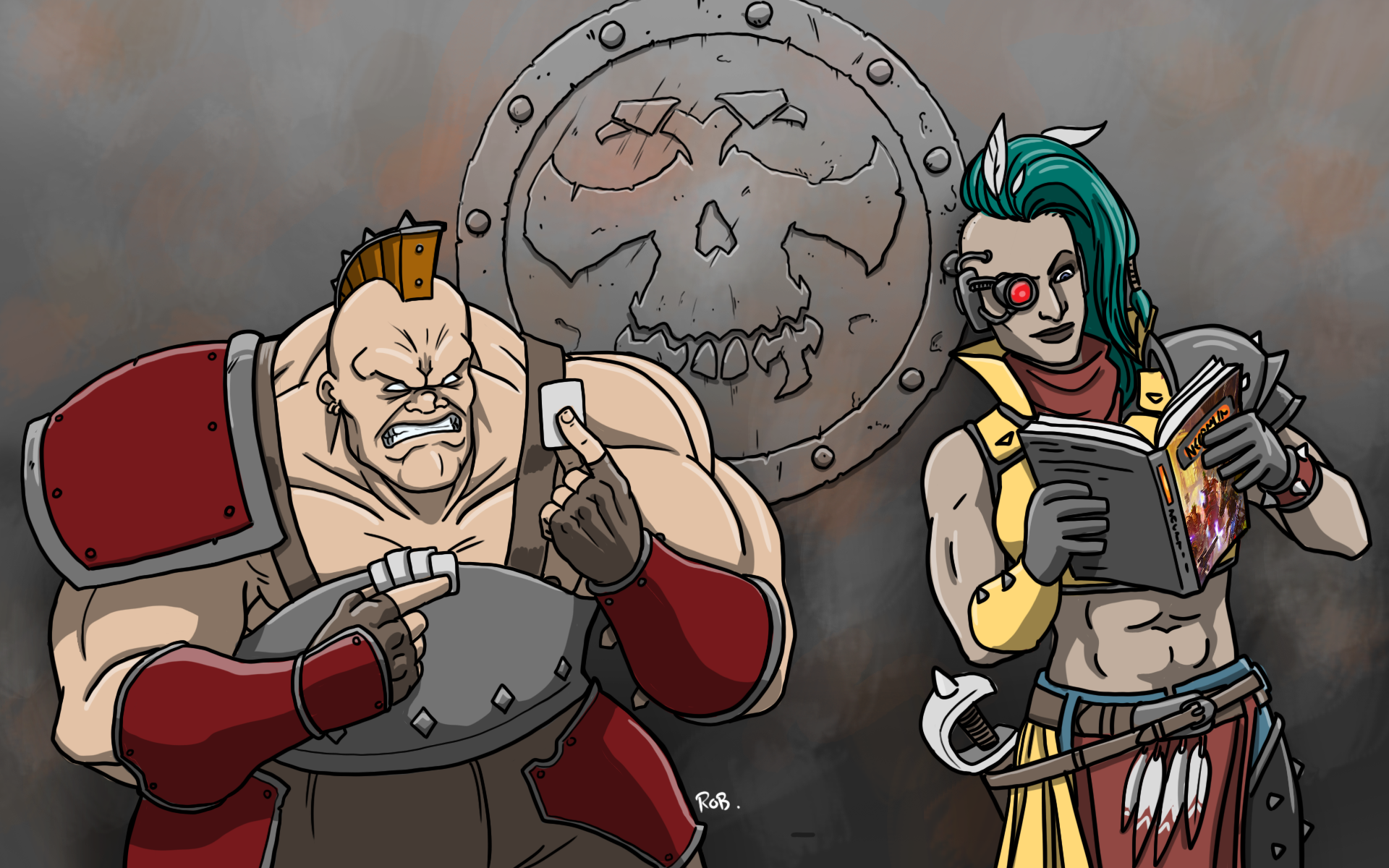The 40k universe stretches well beyond the war-torn battlefields of distant planets. In Necromunda, violent gangs clash in the tunnels and sewers of the planet’s largest hive city. Continuing this week, Dan “Sex Cannon” Boyd, Jules “Merton” O’Hare, and Kevin Fowler will be covering everything Necromunda, reviewing new releases, talking strategy, and how to run campaigns.
Welcome back, fellow Scummers! Necromunda can be a complicated game, but don’t write it off as too tricky to get started. This week, we’ll be covering the very basics, the stuff you need to know before you even pick up your sprue clippers, everything we wish we’d known before we first hopped into the Underhive!
What even is Necromunda?
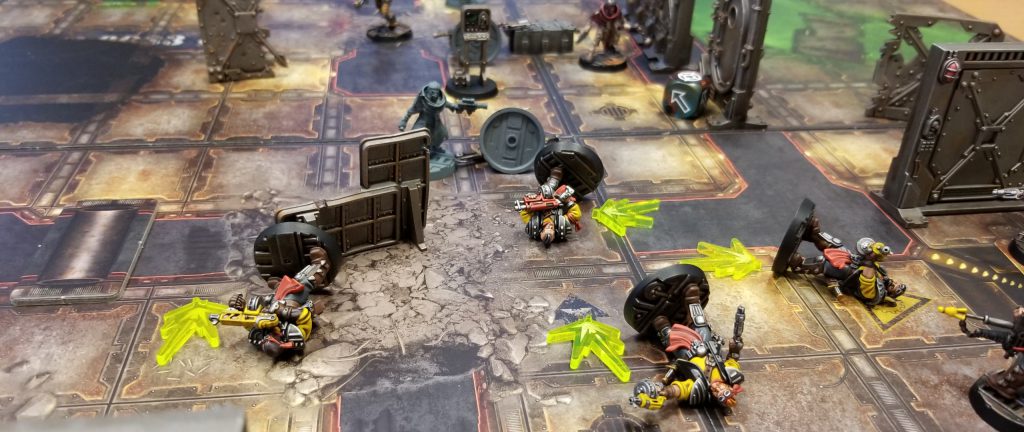
Necromunda is a skirmish combat gang featuring desperate gangs of violent criminals duking it out over territory in the dangerous and deadly Underhive. It’s murder-hobos vs. bikers vs. steroid freaks vs. incels vs. techno-cancer patients vs. riot girls vs. rent-a-cops vs. apocalyptic cultists vs. dudes who watched Alien and identified with the xenomorph vs. cannibals who may be young but are certainly not fine and it is absolutely wonderful. Games frequently turn into chaotic scrums where multiple characters are on fire or falling off of buildings (or both!), while one fighter uses a grapnel launcher to execute a three-story diving elbow like they’re Macho Man Randy Savage playing for keeps.
You should be playing Necromunda.
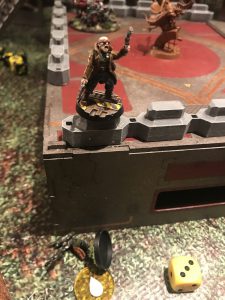
But isn’t there already a GW sci-fi skirmish game?
Yes! Kill Team exists and is a ton of fun. Necromunda, however, scratches a different itch for many hobbyists. While Kill Team is a streamlined introduction to the game of Warhammer 40,000 meant to be played over less than an hour, Necromunda is a much more complex and grognard-y take on skirmish combat. Each model is a character with individual flavor: different equipment, skills, names and even personalities set characters apart and turn the experience into a more narrative game.
Necromunda also has many more rules detailing special ammunition, interactions with terrain, specific injuries, and even has hirable neutral characters like hive scum and bounty hunters. Necromunda is also geared towards campaign play, where gangs grow in size and strength (or die ignominiously) throughout the arc of the campaign, leading to epic match-ups and bitter competition between players.
While Kill Team does a bang-up job of scratching the fast-paced sci-fi skirmish game itch, Necromunda allows for more complexity, ridiculousness, and setting people on fire, which in our minds is a big plus!
That sounds really cool, what do I need to actually play a game?
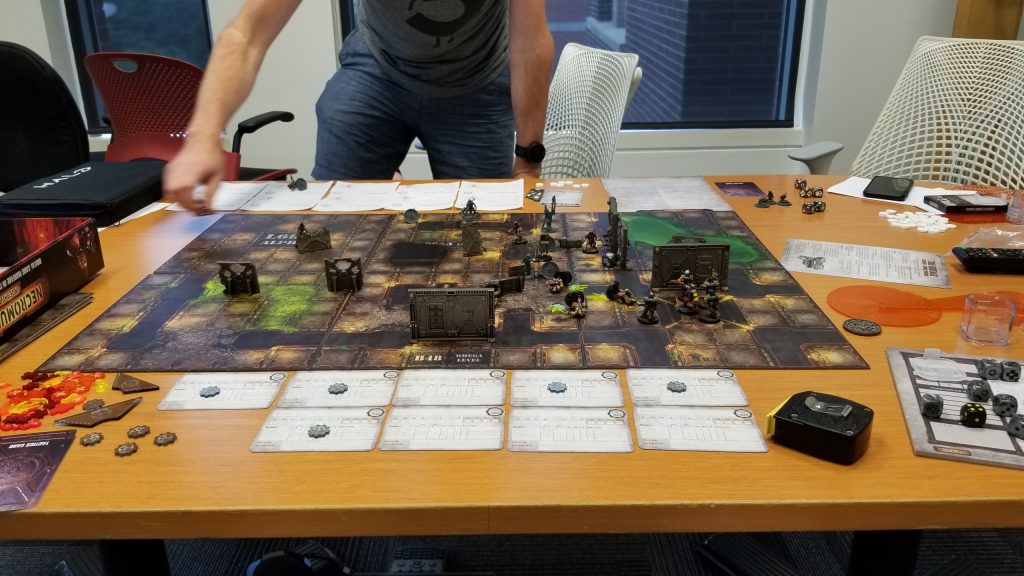
How deep do you want to go? Necromunda has multiple points of entry nowadays, which can be a bit confusing to navigate! For those looking to get a fresh start, the recently released Necromunda: Hive War boxed set is a one stop shop. Check out our review! Hive War has two 10-member gangs (the swift, chem-brewing Escher vs the crafty, backstabbing Delaque), an updated / streamlined rulebook, a game mat, some walls & barricades, dice, and more templates & tokens than you will know what to do with. This is everything you need for two people to start playing. Keep in mind that gang lists, gear, and campaign options are limited out of the box! If you are looking to get serious, picking up you gang’s “House of” book (see below) is a great next step.
Another boxed set option is a weirder one – Necromunda: Underhive. This box is out of print, and comes with an outdated rulebook. However, the rest of the contents of the box are an extremely good value. It comes with barricades and doors, counters, dice, two entire gangs (Escher vs Goliath), blast markers, and most importantly, Zone Mortalis tiles that cannot be bought individually (more on this later!). If you can find a dusty copy at your FLGS, consider picking it up – those ZM tiles are worth their weight in gold!
What do I need if I am joining a campaign and just need the rule books? Unfortunately, the answer is a bit complicated right now. Players should definitely pick up Necromunda: The Rulebook, but gang-specific rules are fractured a bit as we are in the middle of the release cycle! Gangs of the Underhive functions as a house gang index, but some crews have codex-style “House Of:” books with additional ganger types and options. In addition, there are several “Book of” supplements that add additional campaign types, options, and non-house gangs.
We’ll break down which books have rules for specific gangs: The Book of Peril, The Book of Judgement (Palanite Enforcers), The Book of Ruin (Corpse Grinder Cults, Chaos Cults & Genestealer Cults), House of Chains (Goliath & Slave Ogryn), House of Blades (Escher), House of Iron (Orlock), House of Artifice (Van Saar), and we are still waiting on the release of House of Faith (Cawdor) and House of Shadows (Delaque).
Okay, so you have the rules, now you need a gang! This is actually the easiest part. All of the six house gangs in Necromunda are available in plastic from GW. Additionally, Forge World has released multiple weapon packs for each gang that totally open up the armament options. There are also hangers-on, bounty hunters, hive scum, and brutes available from GW and FW to fill out the Underhive weirdos that you might need during a campaign. Not everything represented in the rules is available as a model, but the vast majority is right there and ready to buy.
Finally, you’ll need your play aids. Measuring tape, dice, counters, roster, and fighter cards. We strongly suggest that you have fighter cards made up before the battle so you can reference them during. You can also use them to track your condition counters like insanity or blaze. You’ll also need Tactics Cards, and these are a frustrating mess. Released in the boxed game and with every gang release, a player would have had to have been extremely diligent to ensure they had access to all ~160 of the Tactics Cards. This is crazy stupid. However, we have a solution for you, because of course we do! The Sex Cannon has written two articles on tactics cards and their use. Go read ‘em!
That’s all cool, but let’s get to the gangs!
We agree. There are six Houses of gangs, two 40k tie-in gangs, the crusty old bounty hunter gang, and Necromunda rent-a-cops. We’re going to broadly lay out their style and flavor here, and updating this overview as we dive deeper in the future!
Goliath

Muscled-up steroid freaks that have turned industrial machinery into brutal weapons. Most of them have mohawks, and all of them have bad attitudes.
Strengths: Tougher and stronger than every other gang, extremely difficult to kill, melee monsters. Tanky skills and great short-range firepower make Goliaths one of the best gangs in Zone Mortalis games.
Weaknesses: Slow, with mediocre ranged threats beyond close range. Goliaths will generally have fewer models than most other gangs as their fighters run to the expensive side of things.
Related Articles
How to Play Goliaths
The House of Chains Review
Escher
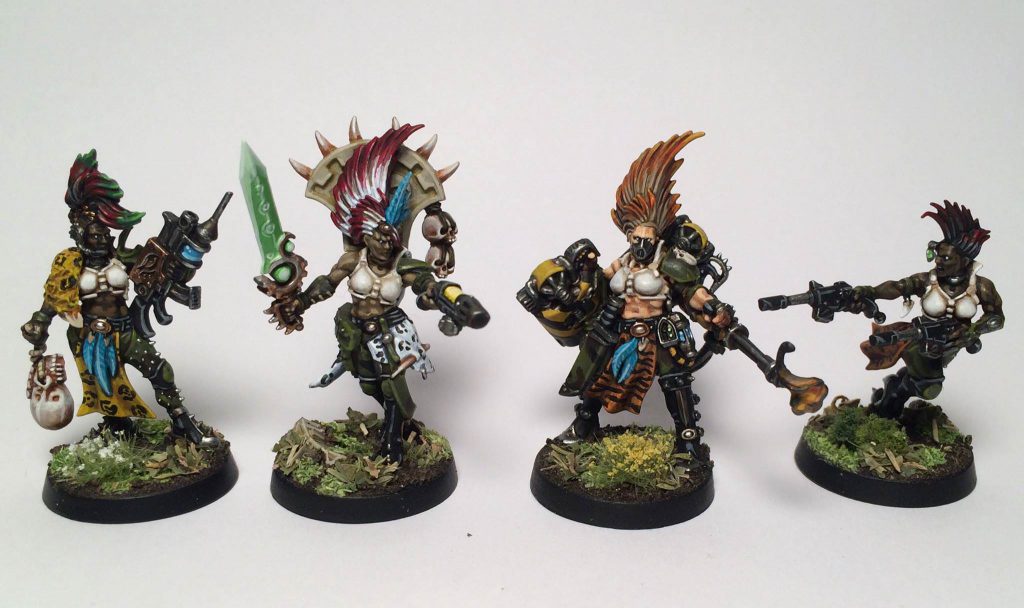
The most unique House in Necromunda, House Escher fields gangs entirely made up of women. Masters of speed, agility, and poisoned weaponry, House Escher fighters can kill your whole gang and look fabulous while doing it.
Strengths: Plentiful long-ranged firepower and high speed. Poisoned weapons to deal with multi-wound models who get too close for comfort. With cheaper gangers and lots of effective basic weapons, expect Escher gangs to have numerical superiority, too.
Weaknesses: Glass cannons. Not built for sustained combat, or prolonged firefights, or stressful situations. Get up in their face, and Escher gangs will generally fold like a bad hand.
Related Articles
How to Play Eschers
House of Blades Review
Van Saar
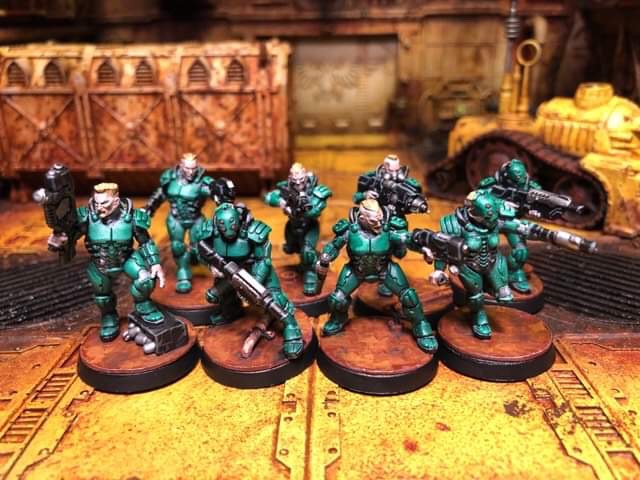
Van Saar: The foundries and factories of House Van Saar create the most technologically advanced weaponry used in Necromunda, but at a cost: each Van Saar ganger is an irradiated weakling who relies on their high-tech pajamas to keep them alive.
Strengths: The highest accuracy gang, shooting the nastiest high-tech guns. Seriously, leaders and champs in this gang start with a 2+ ballistic skill! Shooting skills at the jump will also make this gang one of the most dangerous low-rating gangs out there.
Weaknesses: Melee, losing line of sight, frequent mocking comparisons to Tau. The key to beating Van Saar is getting them to play in Zone Mortalis games and then punching them until they are dead. It’s hard to aim with a knife in the eye, after all. Van Saar also have some of the most expensive fighters, so expect them to be at a numerical disadvantage.
Related Articles
How to Play Van Saar
House of Artifice Review
Orlock
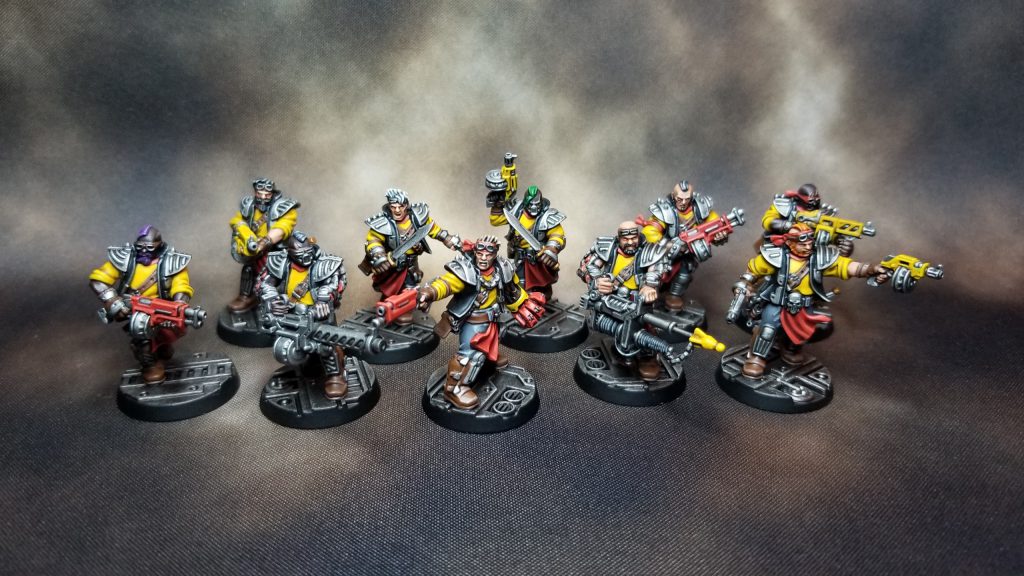
House Orlock is known for three main things: Iron, brotherhood, and a penchant for brutal violence that is emblematic in their choice of weapons and gear. They don’t have access to steroids, narcotics, technology, or high quality razor blades like some of the other houses, but they make up for it with grit, determination, and lots and lots of bullets.
Strengths: Orlocks are the masters of the short-range firefight. Cheap combat shotguns, bolters, and plenty of flame weapons make them an absolute nuisance between 8” and 12”. Gangers are relatively cheap, their weapons are good, and the Orlock Leader is the best starting character in the game. Tanky skills and good armor make them one of the more survivable gangs, too.
Weaknesses: While they might excel at short range, Orlocks suffer in combat, and can easily be out-shot at range by Escher, Delaque, and Van Saar. They’re meant to be the all-rounders of Necromunda, and that means that they can be pulled out of position rather quickly.
Related Articles
How to Play Orlocks
House of Iron Review
Cawdor
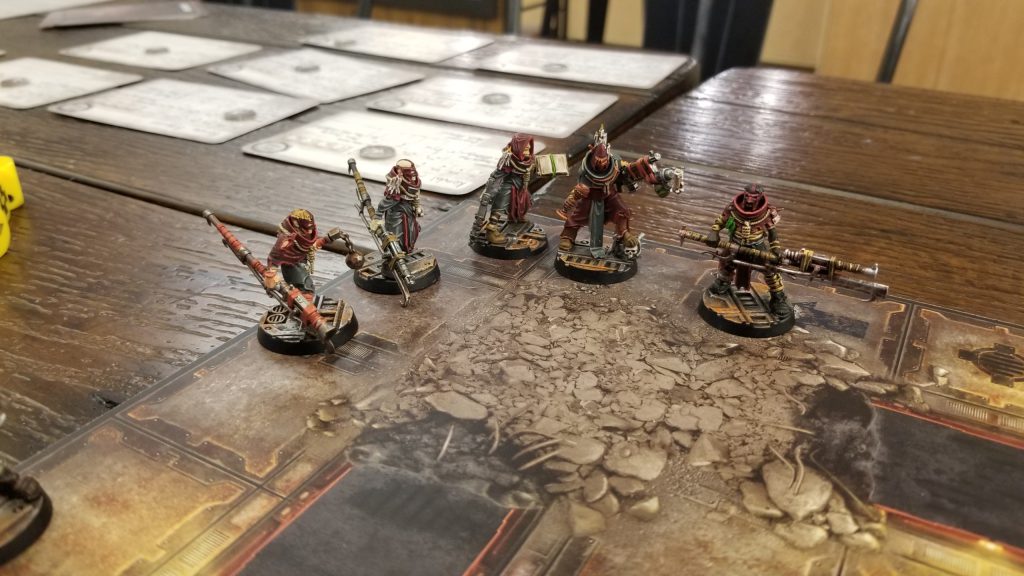
Ah, the trashbois. Cawdor live their lives sorting through the waste of the other houses. They’re a necessary part of Necromunda’s “ecosystem” and they lay claim to all things discarded and lost. Individual lives mean little to House Cawdor, the only things they really care about is worshipping the Emperor and burning heretics.
Strengths: Cheap bodies to outnumber their opponents, blunderbusses and flamethrowers and incendiary charges to set you on fire. Unique weapon options and cheap troops really set this gang apart.
Weaknesses: Individually weak, prone to fleeing as their numbers diminish. Terrible at range, very bad skill choices, and weapons that are prone to malfunction are low points for the trashbois. Catch them at longer ranges in a Sector Mechanicus game and they’re in trouble.
Related Articles
Delaque
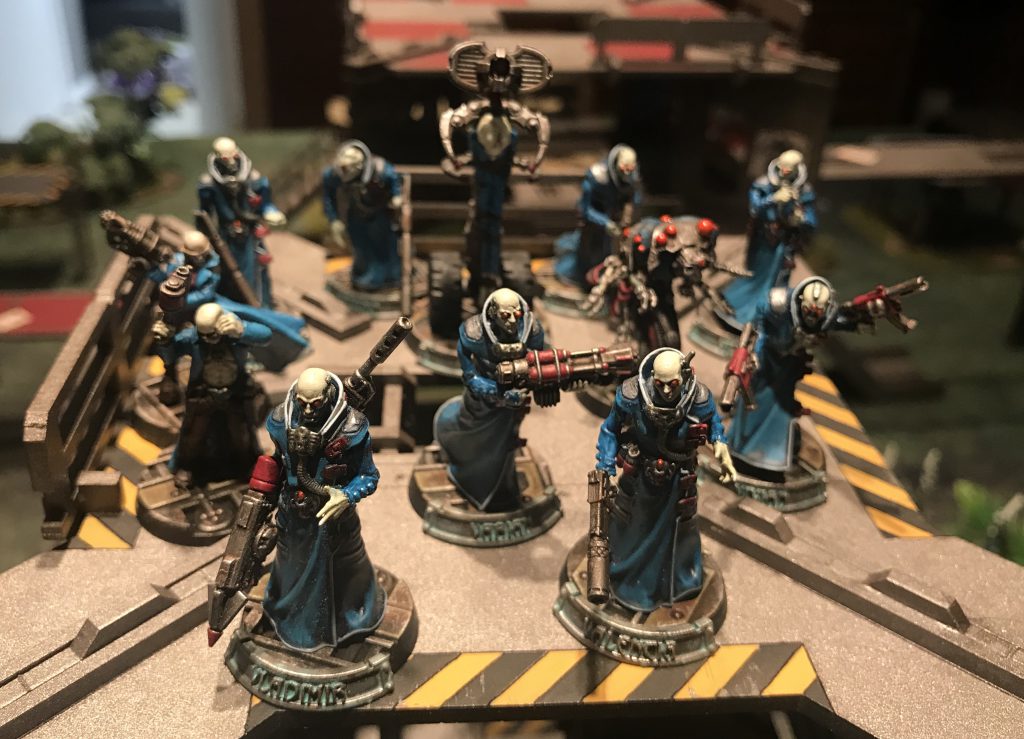
House Delaque is, unofficially of course, Necromunda’s spy network. Information brokers par excellence, House Delaque are masters of stealth, ambush tactics, and subterfuge. Nobody trusts them, but everyone needs them.
Strengths: Close-ranged shooting, sniper rifles, status-disrupting grenades, web guns, general shenanigans. If you want to play the gang that can do the absolute most to screw with your opponent, this is the gang for you. Skill choice is also excellent, with primary access to both Shooting and Cunning.
Weaknesses: Difficulty dealing significant damage to more than two enemies in a round. Close combat abilities are a joke, and there are several hard counters to their shenanigans.
Related Articles
Genestealer Cults
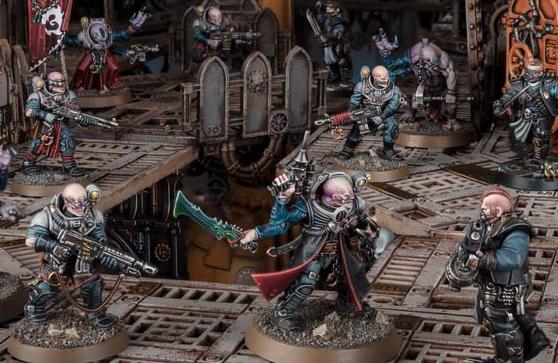
The first of the 40k tie-in gangs, Genestealer Cultists represent the insidious alien menace of the Tyranids in Necromunda’s Underhive. If you’ve got a GSC army, then you’ve got a Necromunda gang just waiting to introduce themselves via industrial equipment and sharp claws!
Strengths: Cult Alphas are one of the most powerful leader models in the game. Aberrants are close combat monsters, and the whole gang can start with hazard suits which counter a lot of the other gangs’ chicanery!
Weaknesses: Cult Adepts and Hybrid Acolytes suck on ice, and all of the cool weapons are point traps. You’d think that the psychic powers would be good, but they don’t hold a candle to the far superior Cult Alpha.
Related Articles
Chaos Helot Cults
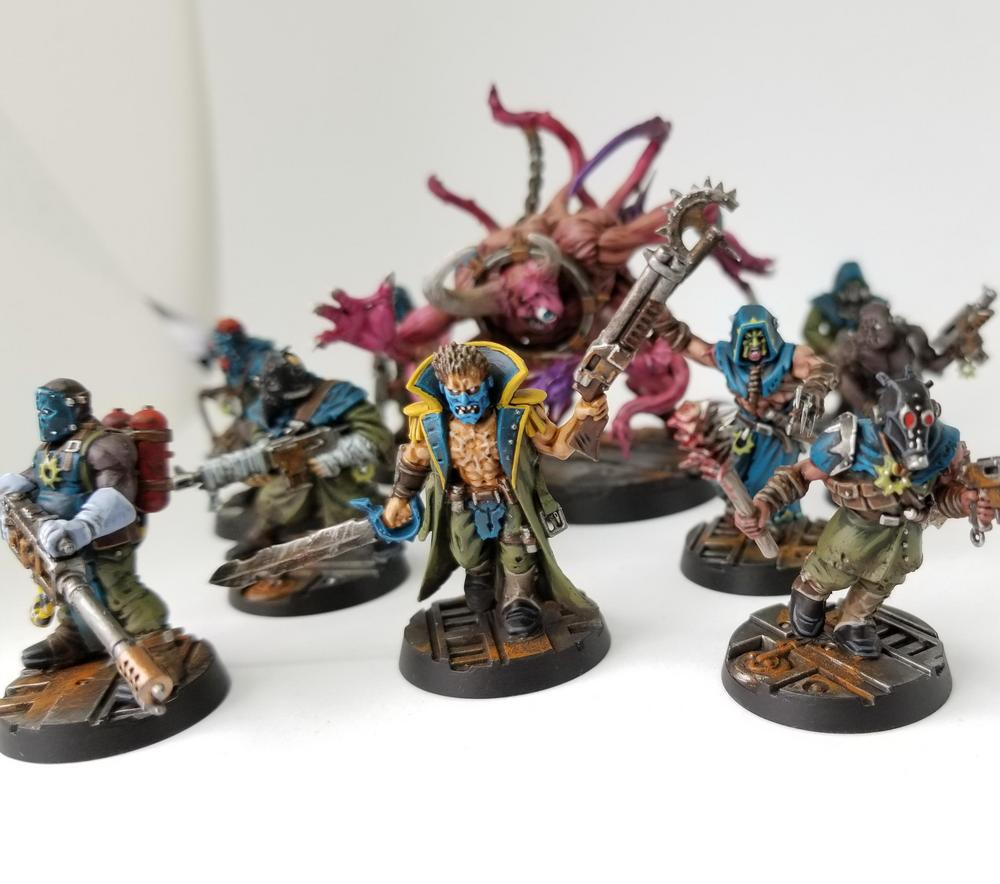
If you’ve got a bevy of 40k Chaos Cultists lying around (or a Blackstone fortress set!) then you’ve got a Chaos Cult in the making! This gang can do a lot of fun things including psychic powers, gaining the favor of the dark gods, and summoning a Chaos Spawn for the low, low price of one of your cultists! They’re one of the most flavorful gangs possible, and that’s really saying something.
Strengths: Mechanics like Dark Rituals can add gang-wide bonuses that can easily turn the tide of a battle. You have access to a psyker. Cheap basic gangers mean that you’ll almost always outnumber your opponent. The Chaos Spawn can be a terror on the battlefield…
Weaknesses: …but you can also roll poorly on its stats and have it be a total dud. The Psychic powers don’t really do anything, and your fighters will rarely be anything more than middle-of-the-road.
Related Articles
How to Play Chaos Helot Cults – (OK we don’t have this one yet but it’s in the works. Stay tuned, scummers!)
Corpse Grinder Cults
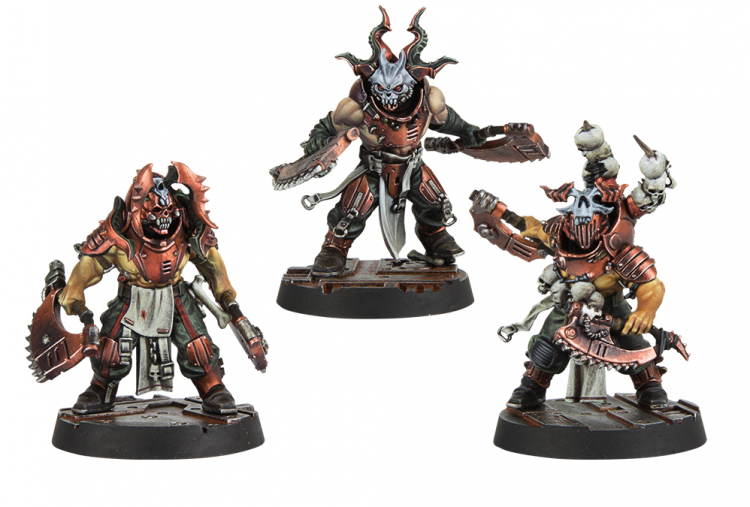
Chaos is a big tent faction, and not limited to just one set of cults. If you want something a bit more aggressive. Corpse Grinder Cults represent the underhive workers who are dedicated to making corpse starch, the recycled human food paste that people in the hive eat who have, over time, gone mad and devoted themselves to the worship of Khorne, becoming deadly butchers. These gangs are almost entirely dedicated to melee combat.
Strengths: You will absolutely mulch your enemies in melee combat, and your fighters are incredibly fast, with some good tricks to ensure that they make it into combat before they’re gunned down. You also have fully directed advancement, meaning that your gangers will advance in the ways you want them to — no random rolls on the advancement table for you!
Weaknesses: You have, at best, garbage-tier shooting and your gang is extremely vulnerable to pinning. It’s melee or bust, buddy.
Related Articles
Initial Impressions of the Corpse Grinder Cults
Venators
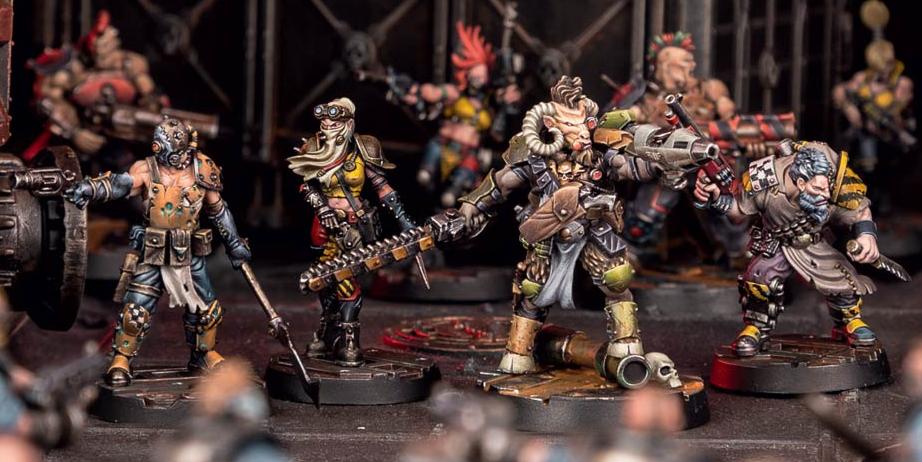
Venators are supposed to represent a gang made out of individual Bounty Hunters from any or none of the previously mentioned Necromunda Houses. They’re itinerant fighters and crusty survivors making life in the Underhive on the backs of their combat abilities. They’re totally customizable, and no two Venator gangs will be alike!
Strengths: Customization! Venators don’t have a style or flavor of their own and instead rely on the player to lend them their personality. They have access to the entire trading post, and a canny player can make some superbly nasty combos with which to surprise their opponents. House Legacies allow Venator hunters to cherry-pick from other gang’s armory of their choosing.
Weaknesses: Generally fewer models and reliance on individuals could seriously stunt a Venator gang in a campaign.
Related Articles
How to Play Venators (coming soon)
Enforcers

Necromunda’s corrupt and brutal police force. Tired of criminals running wild in the Underhive? Want to violently enforce the whims of the status quo? Then grab a box of Enforcers and descend into the darkened tunnels to crack some heads and put boot to ass!
Strengths: Strong starting equipment, another solid all-rounder gang with a more elite bend compared to Orlocks. Bolters and shotguns and grenade launchers in surplus.
Weaknesses: Trading Post access restrictions mean Enforcers can fall behind in a last-campaign arms race as other gangs begin to acquire some weird and nasty weaponry.
Related Articles
Slave Ogryns
Slave Ogryns, like the Corpse Grinders before them, are a primarily close-combat oriented gang. There’s no shenanigans with the Ogryns, like tricksy masks or infiltrating little men, only giants lumbering towards their enemy ready to crush them up in massive bear hugs!
Strengths: Strength. And Toughness. Every model in your gang has Toughness 5, and your models are the biggest, most physically intimidating gang in the underhive. Also you’re Strength 5, and early in campaigns you’re going to wreck house.
Weaknesses: Going the distance is gonna be hard. Ogryns are built for long battles, but not long campaigns. You’ve got a number of weapon restrictions going against you, you’ll have a hard time countering Special Weapon traits, and if you’re in a Law and Misrule campaign, you’re always classified as Outlaws. Also you’re going to find yourself running into better and better guns as campaigns go on.
Related Articles
So you’ve mentioned Zone Mortalis and Sector Mechanicus. What are those?
Zone Mortalis (ZM) and Sector Mechanicus (SM) are the two types of battlefields you can play on in Necromunda. ZM boards use 12” square tiles (or 2×2 game matsto procedurally generate a new battlefield for every game. SM battlefield are your more traditional tabletop terrain set-ups with plenty of gantries, walkways, and platforms.

If you wound up grabbing the Underhive boxed set along with your two base rulebooks, you already have a Zone Mortalis battlefield ready to go. There’s no climbing or vertical movement on this playfield, designed to evoke the cramped quarters and claustrophobic corridors of the Underhive. You’ll avoid enemy fire by lurking around corners and operating mechanical doors rather than cowering behind rubble. Since line of sight on these boards is limited, gangs with a focus on short-ranged shooting and close combat can expect to have an advantage.
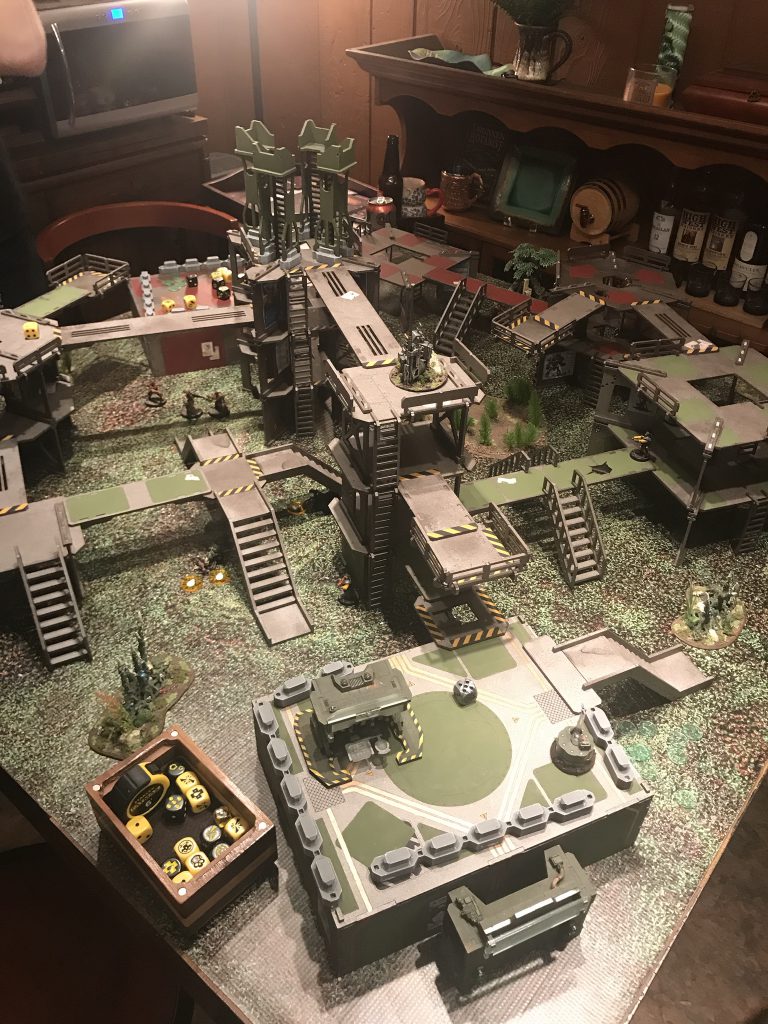
Alternately, if you’re coming into Necromunda from almost any other 28mm wargame, you probably already have terrain usable in the other battlefield style. Though officially named Sector Mechanicus, any and all other terrain is valid as your gangs duke it out. We personally recommend a denser board in a city-fight style, as too many clear firing lanes can make games feel a bit one-sided, depending on the combatants (looking at you, Van Saar).
From there, the main book contains over a dozen different scenarios to be run on the two battlefield styles. Stand-off and Tunnel Skirmish are the two simplest missions, and play out like your standard run-of-the-mill deathmatch. Beyond that, the missions tend to be somewhat balanced but generally asymmetrical with each gang acting as attacker or defender to achieve their own particular objectives.
This game sounds like a ton of fun. What’s the next step?
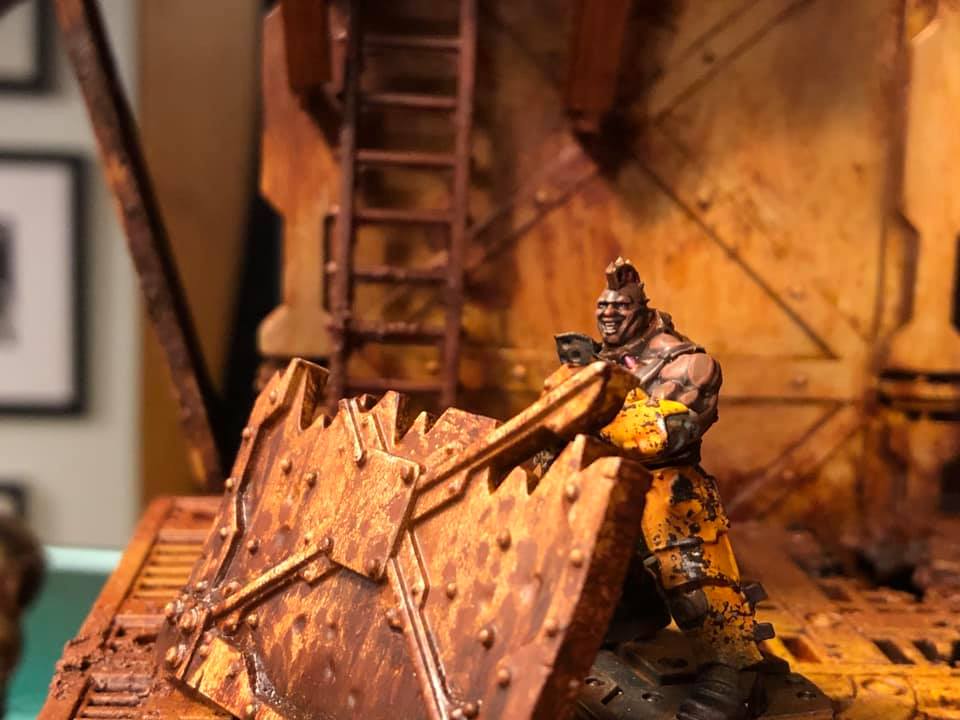
Simple! Grab the gang you think is the coolest, build ‘em up, and make a 1000 credit list! You can consult your books and use a pen and paper if you wish, but the fine people over at yaktribe.games have online resources set up for gang creation and campaign tracking. It’s definitely worthwhile to check them out.
While it may be daunting to some people to build a gang from scratch, a good starting point for most gangs is to take a leader, two champs, a juve, and four gangers. Creating a gang to your taste might result in a different composition, but seven or eight bodies at inception is awfully helpful for winning games. Think about where you’re likely to actually play your games, too. All flamers might seem cool, but you’ll get dumpstered in a Sector Mechanicus game without some serious shenanigans.
After that, grab a bud and get playing! You’ll be blasting people off of high balconies with shotguns in no time!
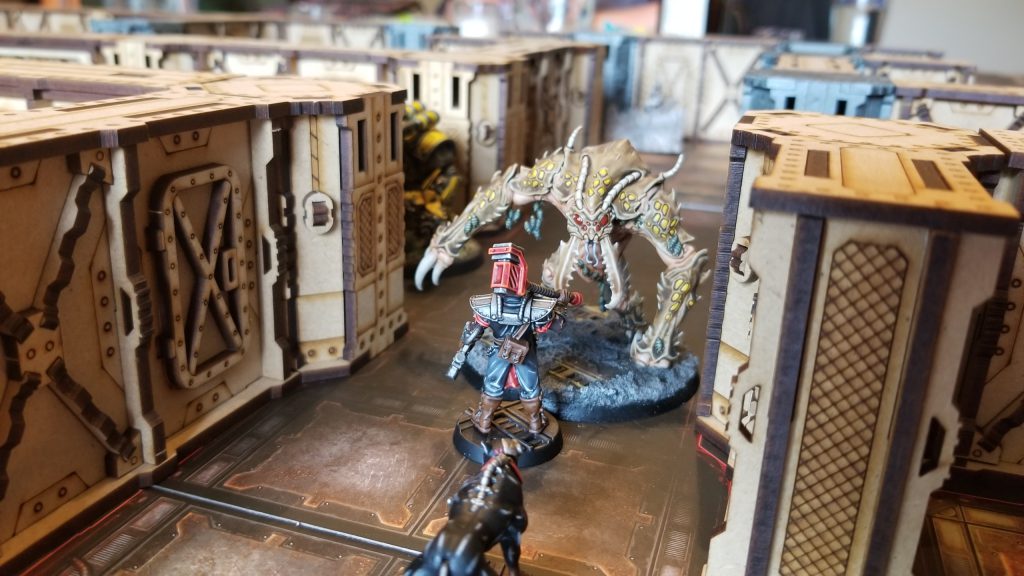
Campaign Play
One-off games of Necromunda are fun, but long-term campaign play is where the real action is at. Necromunda is made to be played in longer campaigns, with gangers leveling up, improving their skills, and gangs growing in influence and power as time goes on. Necromunda has multiple campaign scenarios to choose from, with different mechanics for control and influence depending on which book you’re pulling rules from.
Related Articles
The Dominion Campaign Territories
Lost Zones – A Goonhammer-authored custom campaign format
There’s More Where That Came From
That wraps up our introduction, but we’ll be releasing weekly Necromunda content on Mondays going forward, and if there’s anything you’d like to see in the future, please leave a comment or email us at contact@goonhammer.com! Also feel free to hit us up with any questions – we’ll try our best to answer them, either directly or in a semi-recurring mailbag column.

